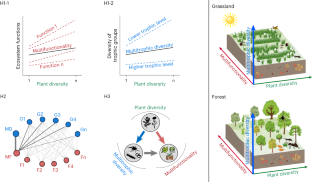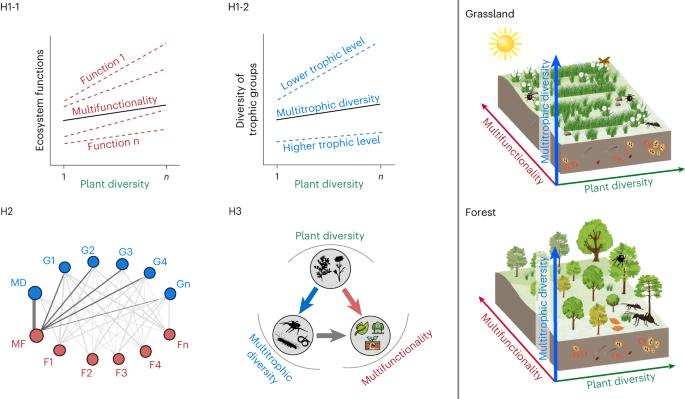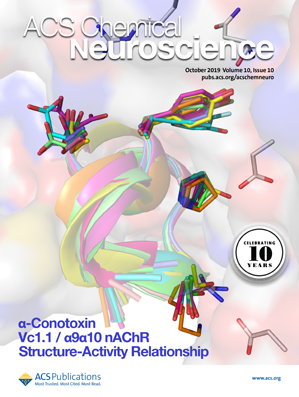Plant diversity enhances ecosystem multifunctionality via multitrophic diversity
IF 4.1
3区 医学
Q2 BIOCHEMISTRY & MOLECULAR BIOLOGY
引用次数: 0
Abstract
Ecosystem functioning depends on biodiversity at multiple trophic levels, yet relationships between multitrophic diversity and ecosystem multifunctionality have been poorly explored, with studies often focusing on individual trophic levels and functions and on specific ecosystem types. Here, we show that plant diversity can affect ecosystem functioning both directly and by affecting other trophic levels. Using data on 13 trophic groups and 13 ecosystem functions from two large biodiversity experiments—one representing temperate grasslands and the other subtropical forests—we found that plant diversity increases multifunctionality through elevated multitrophic diversity. Across both experiments, the association between multitrophic diversity and multifunctionality was stronger than the relationship between the diversity of individual trophic groups and multifunctionality. Our results also suggest that the role of multitrophic diversity is greater in forests than in grasslands. These findings imply that, to promote sustained ecosystem multifunctionality, conservation planning must consider the diversity of both plants and higher trophic levels. Research on biodiversity–ecosystem functioning relationships tends to focus on single trophic groups. This analysis of two biodiversity experiments, representing forests and grasslands, shows that plant diversity promotes ecosystem multifunctionality not only directly, but also by enhancing the diversity of other trophic levels.


植物多样性通过多营养多样性增强生态系统的多功能性
生态系统的功能取决于多个营养级的生物多样性,然而多营养级多样性与生态系统多功能性之间的关系却鲜有探讨,研究往往集中于单个营养级和功能以及特定的生态系统类型。在这里,我们表明植物多样性既能直接影响生态系统功能,也能通过影响其他营养级来影响生态系统功能。利用来自两个大型生物多样性实验(一个代表温带草原,另一个代表亚热带森林)的 13 个营养群和 13 种生态系统功能的数据,我们发现植物多样性可通过提高多营养群多样性来增加生态系统的多功能性。在这两项实验中,多营养群多样性与多功能性之间的关系要强于单个营养群多样性与多功能性之间的关系。我们的结果还表明,多营养群多样性在森林中的作用比在草原中更大。这些研究结果表明,为了促进生态系统的持续多功能性,保护规划必须同时考虑植物和较高营养级的多样性。
本文章由计算机程序翻译,如有差异,请以英文原文为准。
求助全文
约1分钟内获得全文
求助全文
来源期刊

ACS Chemical Neuroscience
BIOCHEMISTRY & MOLECULAR BIOLOGY-CHEMISTRY, MEDICINAL
CiteScore
9.20
自引率
4.00%
发文量
323
审稿时长
1 months
期刊介绍:
ACS Chemical Neuroscience publishes high-quality research articles and reviews that showcase chemical, quantitative biological, biophysical and bioengineering approaches to the understanding of the nervous system and to the development of new treatments for neurological disorders. Research in the journal focuses on aspects of chemical neurobiology and bio-neurochemistry such as the following:
Neurotransmitters and receptors
Neuropharmaceuticals and therapeutics
Neural development—Plasticity, and degeneration
Chemical, physical, and computational methods in neuroscience
Neuronal diseases—basis, detection, and treatment
Mechanism of aging, learning, memory and behavior
Pain and sensory processing
Neurotoxins
Neuroscience-inspired bioengineering
Development of methods in chemical neurobiology
Neuroimaging agents and technologies
Animal models for central nervous system diseases
Behavioral research
 求助内容:
求助内容: 应助结果提醒方式:
应助结果提醒方式:


